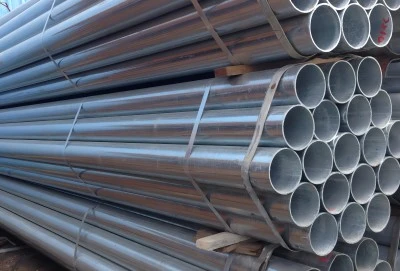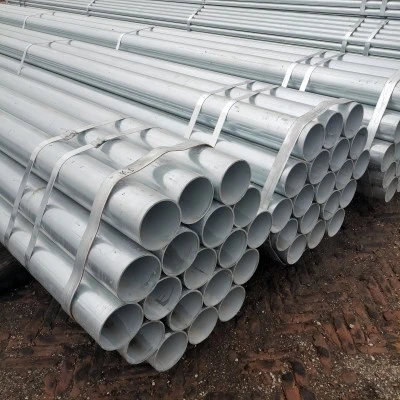Galvanized round tubing is a popular choice for various applications, from construction to agriculture, due to its corrosion-resistant properties. But is it truly rust-proof? This article delves into the science behind galvanization, its effectiveness in preventing rust, and factors that influence its longevity.
|
|
|
How does zinc coating protect galvanized round tubing from rust?
Galvanization is a process that involves coating steel or iron with a layer of zinc. This protective layer acts as a barrier between the metal and corrosive elements in the environment, significantly reducing the risk of rust formation. The zinc coating on galvanized round tubing protects the underlying steel in two primary ways:
1. Barrier Protection: The zinc layer forms a physical barrier that prevents moisture, oxygen, and other corrosive elements from coming into direct contact with the steel. This barrier is the first line of defense against rust formation.
2. Sacrificial Protection: Zinc is more reactive than steel, meaning it will corrode preferentially when exposed to corrosive elements. This sacrificial action protects the underlying steel even if the zinc coating is scratched or damaged, as the zinc will continue to corrode instead of the steel.
The galvanization process for round tubing typically involves hot-dip galvanizing, where the steel tubing is immersed in molten zinc at temperatures around 450°C (842°F). This process ensures a uniform and durable zinc coating that bonds metallurgically with the steel surface, providing long-lasting protection against rust and corrosion.
While galvanized round tubing is highly resistant to rust, it's important to note that it's not entirely "rust-proof." Under certain conditions, such as exposure to highly acidic environments or prolonged contact with moisture, even galvanized tubing can eventually develop rust. However, the zinc coating significantly extends the lifespan of the steel and provides superior protection compared to uncoated steel.
How long does galvanized round tubing resist rust in outdoor applications?
The durability of galvanized round tubing in outdoor applications can vary significantly depending on environmental factors and the quality of the galvanization process. In general, properly galvanized tubing can resist rust for several decades in typical outdoor conditions. Here are some factors that influence its longevity:
1. Environmental Conditions: The corrosion rate of galvanized steel is heavily influenced by the environment. In rural areas with low pollution levels, galvanized round tubing can last 50 years or more before showing signs of rust. In contrast, industrial or coastal areas with higher levels of corrosive elements (such as salt spray or industrial pollutants) may see a reduced lifespan, typically ranging from 10 to 25 years.
2. Zinc Coating Thickness: The thickness of the zinc coating directly correlates to the longevity of rust protection. Thicker coatings provide longer-lasting protection. For instance, a coating thickness of 85 μm (microns) can offer protection for up to 50 years in a rural environment, while the same coating might last 25 years in a marine environment.
3. Maintenance: Regular inspection and maintenance can significantly extend the life of galvanized tubing. This includes cleaning to remove accumulated dirt or debris that could trap moisture, and addressing any damage to the zinc coating promptly.
4. pH Exposure: Galvanized coatings perform best in environments with a pH range of 6 to 12. Exposure to highly acidic (pH < 6) or highly alkaline (pH > 12) conditions can accelerate corrosion and reduce the lifespan of the galvanized coating.
5. Temperature: While galvanized coatings can withstand a wide range of temperatures, extreme heat or rapid temperature changes can affect the coating's integrity over time.
It's worth noting that even as the zinc coating slowly corrodes over time, it continues to protect the underlying steel. This means that galvanized round tubing often maintains its structural integrity long after the first signs of zinc corrosion appear.
What role does pipe thickness and coating uniformity play in rust prevention?
The thickness of the galvanized round tubing and the uniformity of its zinc coating are crucial factors in determining its resistance to rust and overall longevity. Both aspects play significant roles in the tubing's ability to withstand corrosive elements and maintain its structural integrity over time.
Pipe Thickness:
1. Corrosion Allowance: Thicker pipes have a greater "corrosion allowance," which is the extra thickness of material that can corrode without compromising the pipe's structural integrity or functionality. This means that even if corrosion does occur, a thicker pipe will take longer to develop rust, which affects its performance.
2. Heat Distribution: During the galvanization process, thicker pipes can distribute heat more evenly, potentially leading to a more uniform zinc coating. This can result in better overall protection against rust.
3. Mechanical Strength: Thicker pipes are generally more resistant to mechanical damage, which can help prevent breaches in the zinc coating that could lead to localized corrosion.
Coating Uniformity:
1. Consistent Protection: A uniform zinc coating ensures that all areas of the galvanized round tubing receive equal protection against corrosive elements. Inconsistencies in coating thickness can lead to weak points where rust is more likely to develop.
2. Reduced Risk of Galvanic Corrosion: In areas where the coating is thinner or inconsistent, there's a higher risk of galvanic corrosion between the zinc coating and the underlying steel. A uniform coating minimizes this risk.
3. Improved Aesthetics: While primarily functional, a uniform coating also provides a more consistent appearance, which can be important in visible applications.
4. Better Performance in Harsh Environments: In challenging environments, such as those with high humidity or exposure to corrosive chemicals, a uniform coating is crucial for maintaining consistent protection across the entire surface of the tubing.
To achieve optimal rust prevention, manufacturers must carefully control both the pipe thickness and the galvanization process. This involves:
- Selecting appropriate steel grades and thicknesses for the intended application
- Ensuring proper surface preparation before galvanization
- Controlling the temperature and immersion time during hot-dip galvanization
- Implementing quality control measures to verify coating thickness and uniformity
Advanced galvanization techniques, such as continuous galvanizing lines for tubular products, can help achieve more consistent coating thicknesses. These processes often involve precise control of zinc bath temperatures, withdrawal rates, and post-galvanizing treatments to optimize coating uniformity.
It's important to note that while thicker pipes and more uniform coatings generally provide better rust protection, they also come with increased material costs. Therefore, the selection of pipe thickness and coating specifications often involves balancing performance requirements with economic considerations.
About LONGMA GROUP
For applications requiring long-lasting, corrosion-resistant tubular products, galvanized round tubing remains an excellent choice. However, it's essential to consider the specific environmental conditions and performance requirements when selecting galvanized products for any given application.
We are Longma Group Limited (LONGMA GROUP), a top-tier ERW/LSAW steel pipe manufacturer in China since 2003. By the end of 2023, our annual output surpassed 1,000,000 tons, reflecting our strong production capacity and market influence.
Our company specializes in providing high-quality galvanized steel tubing, including A53 galvanized pipe, galvanized mild steel pipe, and ERW galvanized pipe. These products are coated according to internationally recognized standards such as DIN 30670, DIN 30678, CSA Z245.20, EN 10339, ISO 21809-1, AWWA C210, and C213, ensuring reliable performance in various applications.
If you're seeking reliable and high-performance galvanized steel tubing solutions, contact us now by sending your inquiries to info@longma-group.com. Our dedicated team is ready to assist you and provide tailored product recommendations to meet your specific needs.














